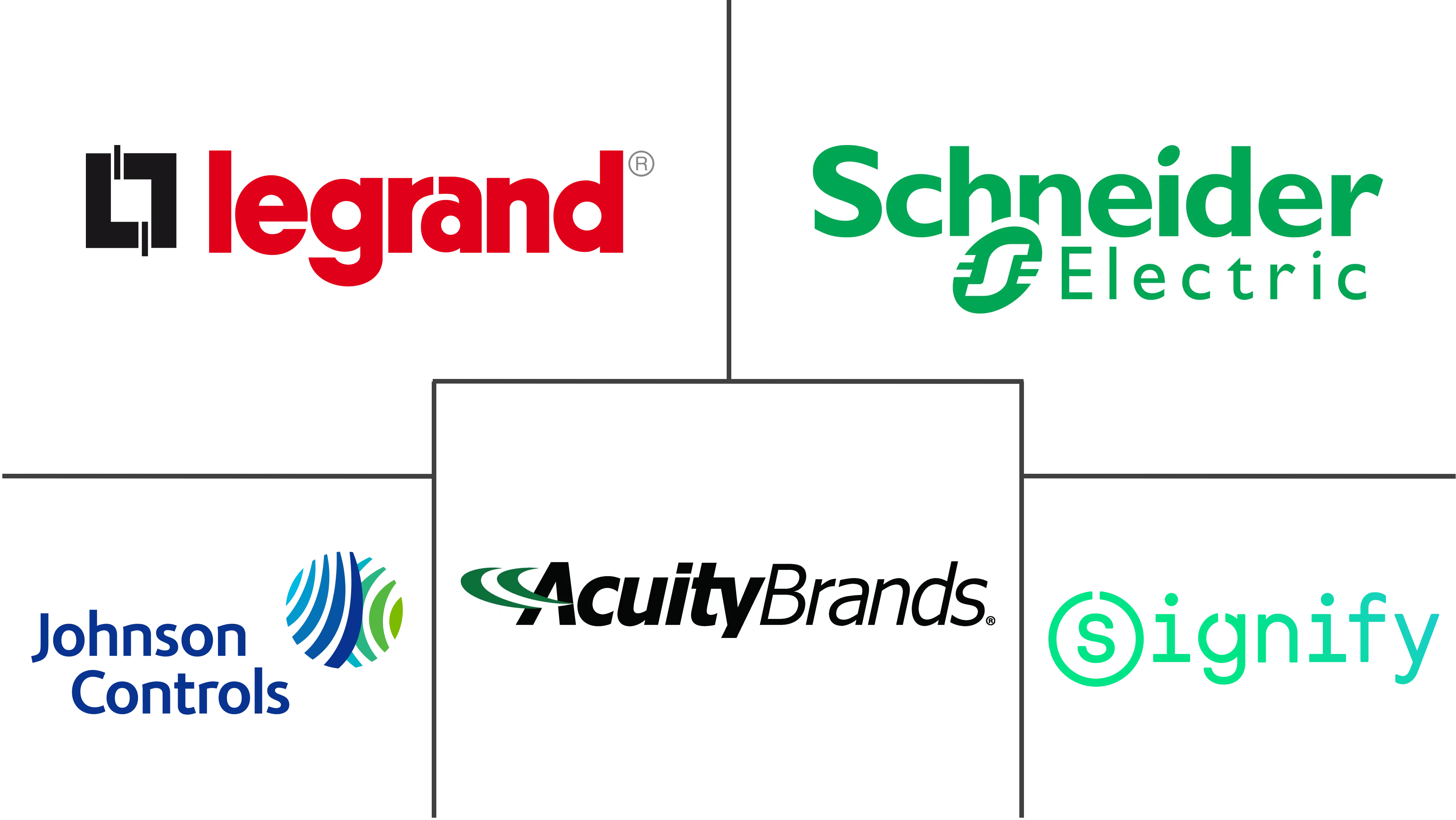Wireless Occupancy Sensors Market Size and Share
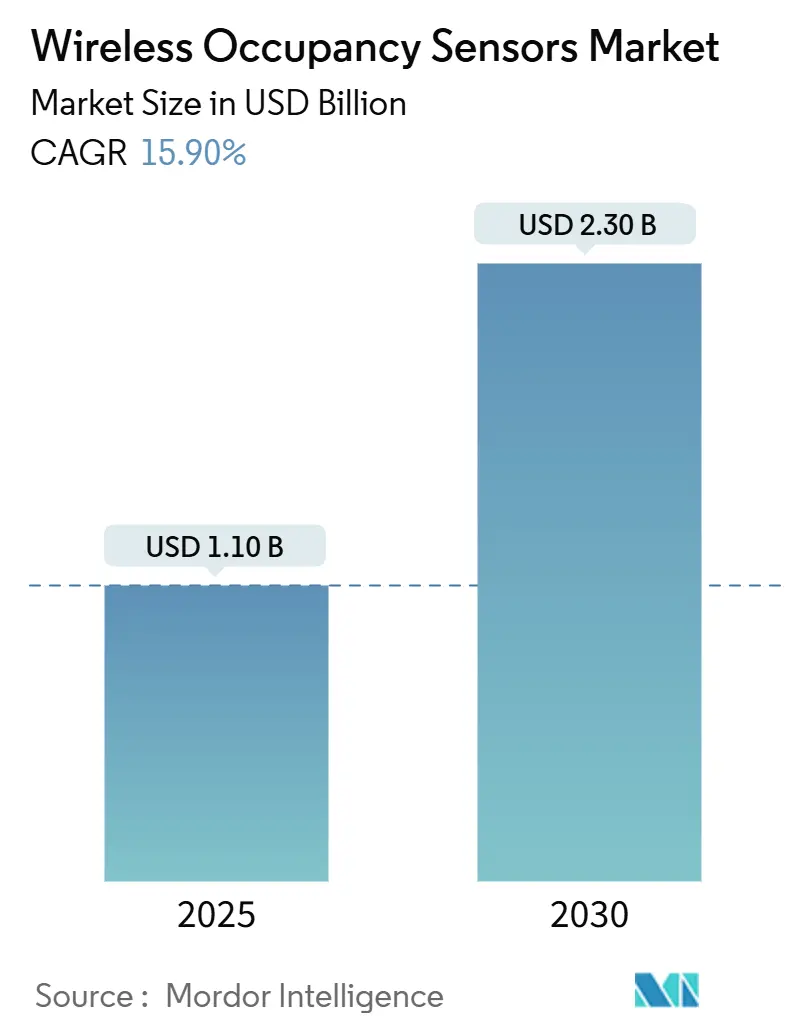
Wireless Occupancy Sensors Market Analysis by Mordor Intelligence
The wireless occupancy sensors market size reached USD 1.1 billion in 2025 and is forecast to climb to USD 2.3 billion by 2030, advancing at a 15.9% CAGR. Surging investment in smart-building platforms, tightening energy-efficiency regulations, and rapid advances in battery-free energy-harvesting designs are the primary engines behind this momentum. Vendors are embedding AI-enabled sensor-fusion algorithms that cut false triggers and raise detection accuracy, while building owners value the reduced maintenance that kinetic, solar, and thermal harvesters provide. Competition is intensifying as lighting majors buy specialist sensor makers to gain data-interoperability advantages, and regional growth profiles mirror regulatory rigor—North America benefits from ASHRAE 90.1-2019 and California Title 24 requirements, whereas Asia-Pacific leverages China’s intelligent-building mandate and Japan’s energy-efficient IoT programs. These converging factors are creating a robust pipeline of retrofit and greenfield projects that will keep the wireless occupancy sensors market on a double-digit growth path through the decade.
Key Report Takeaways
- By technology, Passive Infrared captured 46% of wireless occupancy sensors market share in 2024, while Dual Tech solutions are projected to expand at a 20.5% CAGR through 2030.
- By application, Lighting Control led with 59% revenue share in 2024; HVAC & Ventilation is forecast to grow at a 19% CAGR.
- By building type, Commercial buildings accounted for 54% of the wireless occupancy sensors market size in 2024; Healthcare facilities are poised to rise at an 18.2% CAGR.
- By geography, North America commanded 35% of wireless occupancy sensors market share in 2024, whereas Asia-Pacific is set to register a 17.8% CAGR through 2030.
Global Wireless Occupancy Sensors Market Trends and Insights
Drivers Impact Analysis
| DRIVER | (~) % IMPACT ON CAGR FORECAST | GEOGRAPHIC RELEVANCE | IMPACT TIMELINE |
|---|---|---|---|
| Stringent energy-efficiency mandates | +3.2% | Global, early gains in North America & EU | Medium term (2-4 years) |
| Rapid smart-building & IoT adoption | +4.1% | APAC core, spill-over to North America | Short term (≤ 2 years) |
| Battery-free energy-harvesting sensors | +2.8% | Global, concentrated in commercial sectors | Long term (≥ 4 years) |
| Hybrid-work demand for space analytics | +2.3% | North America & EU, expanding to APAC | Short term (≤ 2 years) |
| ESG-linked occupancy-based HVAC contracts | +1.9% | Global, led by corporate sustainability initiatives | Medium term (2-4 years) |
| AI-enabled mmWave fusion for zero latency | +1.7% | North America & APAC, emerging in EU | Long term (≥ 4 years) |
| Source: Mordor Intelligence | |||
Stringent Energy-Efficiency Mandates
Energy codes such as the European Union’s Energy Performance of Buildings Directive and California Title 24 require automatic lighting and HVAC controls, anchoring long-term demand for wireless occupancy sensors market solutions. New York City’s Local Law 88 adds financial penalties for non-compliance, cementing a regulatory pull that transcends simple payback calculations. Manufacturers see predictable upgrade cycles every five years in the EU and every three years in several U.S. states, which encourages sustained R&D spending. The mandates also catalyze retrofits in small and midsize buildings that previously viewed automation as discretionary. Collectively, these measures add 3.2 percentage points to the forecast CAGR by accelerating project pipelines.[1]European Commission, “Energy Performance of Buildings Directive,” ec.europa.eu
Rapid Smart-Building & IoT Adoption
Smart-building platforms such as Cisco Spaces and Schneider Electric EcoStruxure integrate real-time occupancy data to automate HVAC, lighting, and maintenance, transforming sensors from single-function devices into data nodes that feed enterprise analytics. Thread and Matter protocols now remove interoperability headaches, letting Bluetooth, Zigbee, and Wi-Fi devices coexist without proprietary gateways. Vendors like Aqara ship dual PIR and mmWave sensors that join Apple Home, Alexa, and Google ecosystems out of the box, widening consumer reach. These network effects drive faster adoption curves, particularly in Asia-Pacific’s new commercial builds. As a result, smart-building penetration will deliver the highest driver uplift at 4.1 percentage points to the wireless occupancy sensors market CAGR.
Battery-Free Energy-Harvesting Sensors
Kinetic and solar harvesters end the maintenance bottleneck of battery replacement in ceiling-mounted sensors. EnOcean’s ECO 200 converter powers 2.4 GHz modules indefinitely, slashing lifecycle costs in warehouses where lift equipment rental can exceed sensor hardware costs. Solar variants thrive in naturally lit atria, while thermal harvesters capture HVAC temperature differentials to energize sensors in dim spaces. These designs align with ESG goals by eliminating battery waste and lowering truck rolls for facility teams. The battery-free wave unlocks dense deployments previously deemed uneconomic, adding 2.8 percentage points to growth.
Hybrid-Work Demand for Space Analytics
Hybrid work has turned square-foot optimization into a C-suite priority. AI-powered platforms such as VergeSense reveal underused areas, enabling firms like Fresenius Medical Care to avoid USD 60 million in leases over a decade. Advanced devices like Milesight’s VS121 count people with 95% accuracy while preserving anonymity to meet GDPR requirements. Continuous people counting now supplements binary occupancy signals, supporting dynamic desk assignment and cleaning schedules. Enterprises treat these insights as strategic, paying premiums that fuel a 2.3 percentage-point contribution to the wireless occupancy sensors market CAGR.
Restraints Impact Analysis
| RESTRAINTS | (~) % IMPACT ON CAGR FORECAST | GEOGRAPHIC RELEVANCE | IMPACT TIMELINE |
|---|---|---|---|
| False triggering & calibration issues | -2.1% | Global, dense IoT deployments | Short term (≤ 2 years) |
| Data-privacy & cybersecurity concerns | -1.8% | EU & North America, expanding globally | Medium term (2-4 years) |
| RF congestion in dense IoT deployments | -1.3% | Urban centers globally | Short term (≤ 2 years) |
| Battery-disposal compliance costs | -0.9% | EU & developed markets | Long term (≥ 4 years) |
| Source: Mordor Intelligence | |||
False Triggering & Calibration Issues
Conventional PIR sensors misread HVAC drafts and temperature swings, causing lights to turn on without occupants and eroding energy-savings claims. Ultrasonic Time-of-Flight devices improve detection in such environments, but installers must fine-tune sensitivity, boosting labor costs. Dual-tech fusion reduces false positives yet doubles component count and battery drain. Premium mmWave radar remains costly and needs skilled setup unfamiliar to many electricians. Until AI-assisted auto-calibration standards mature, these technical frictions subtract 2.1 percentage points from the wireless occupancy sensors market CAGR.[2]MulticoreWare Inc., “Challenges of PIR Sensors in HVAC Environments,” multicorewareinc.com
Data-Privacy & Cybersecurity Concerns
GDPR stipulates explicit consent for occupancy monitoring that can trace individuals, limiting data granularity in European offices. Healthcare operators worry that cloud-based analytics could expose sensitive patient movement patterns. Wireless networks create attack vectors; a building-automation breach can escalate into life-safety hazards. Vendors are adding edge processing to keep raw data onsite, but that raises bill of-materials costs. Cyber-insurance underwriters increasingly demand audited sensor firmware, lengthening procurement cycles and dragging the CAGR by 1.8 percentage points.
Segment Analysis
By Technology: Accuracy Drives a Sensor-Fusion Shift
Passive Infrared maintained 46% share in 2024 thanks to low cost and maturity, positioning it as the volume anchor of the wireless occupancy sensors market. Dual-Tech devices that blend PIR and ultrasonic signals are projected to post a 20.5% CAGR as users demand higher precision in air-conditioned open offices. Ultrasonic standalone sensors hold the runner-up slot where stable temperatures favor sound-based motion detection. mmWave radar attracts healthcare, airport, and premium office buyers that need sub-second presence confirmation for critical lighting and HVAC decisions. Computer-vision and acoustic variants remain niche yet gain attention for people-counting accuracy in retail analytics.
Vendor roadmaps increasingly bundle AI fusion engines that learn environmental patterns to slash false positives, improving confidence in the wireless occupancy sensors market. Aqara’s FP300 combines dual PIR, mmWave, temperature, humidity, and illuminance sensing to feed command data into Matter networks. Such platforms use over-the-air updates, protecting investment as algorithms evolve. While BOM costs rise, lifecycle savings from reduced callbacks justify the premium, setting the stage for larger enterprise rollouts.
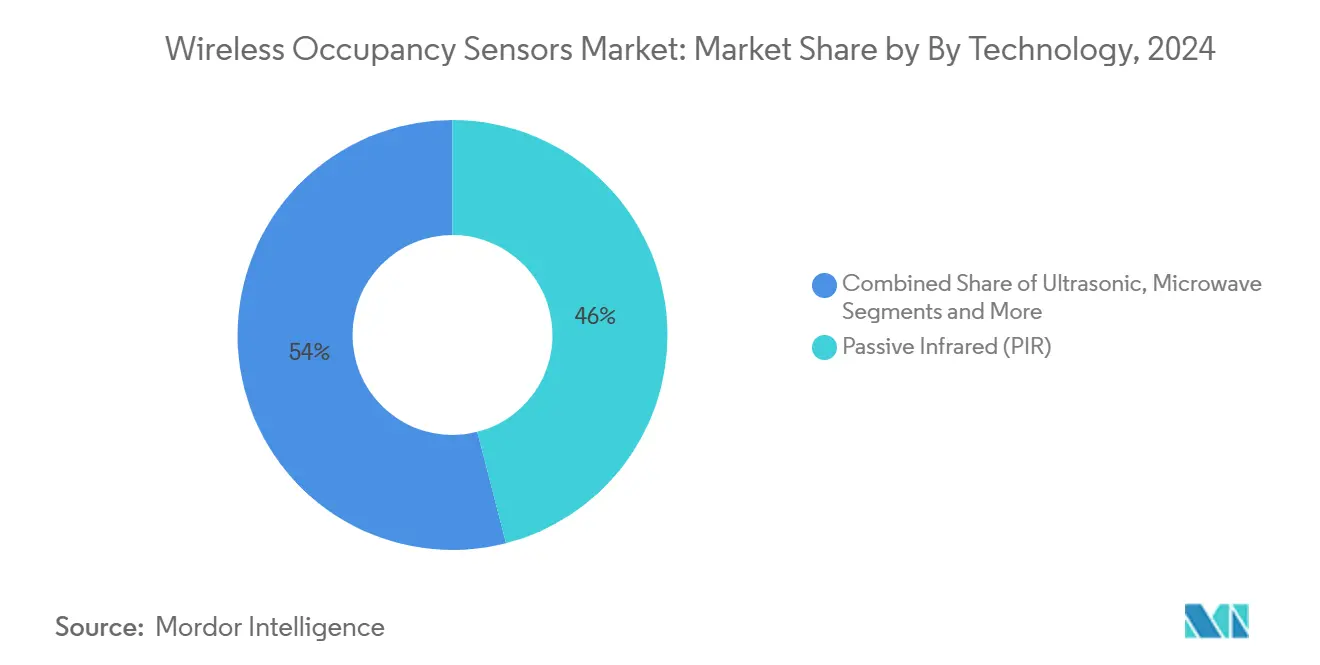
Note: Segment shares of all individual segments available upon report purchase
By Application: HVAC Integration Powers Next-Wave Savings
Lighting Control retained 59% revenue dominance in 2024, benefiting from decades of code-driven deployment in commercial fit-outs. Yet HVAC & Ventilation is forecast to expand at a 19% CAGR, as occupancy data proves essential for right-sizing airflow to post-pandemic indoor-air-quality standards. Security & Surveillance uses sensors for alarm arming and egress path lighting, offering cross-budget synergies. The highest value accrues to Space-Utilization Analytics, where advanced counting functions enable rent optimization in premium real estate.
Honeywell’s Forge Sustainability+ illustrates how occupancy-tuned HVAC can reduce fan energy by 40% while maintaining comfort, unlocking new ROI levers for the wireless occupancy sensors market size tied to energy contracts. Vendors package cloud dashboards that monetize data subscriptions beyond hardware margins. Asset-tracking overlays use the same infrastructure, giving facility managers a multi-service platform that widens TAM without extra capex.
By Building Type: Healthcare Commands Premium Performance
Commercial buildings delivered 54% of 2024 revenue, reflecting broad compliance with energy codes in offices, retail, and hospitality properties. Healthcare facilities, however, promise the fastest advance at an 18.2% CAGR, driven by infection-control protocols and regulatory push for air-change monitoring. Residential smart-home adoption remains steady as consumers install occupancy-based night-lights and climate controls. Industrial plants adopt sensors for safety lockouts and energy savings on production floors.
Hospitals demand precise presence data without infringing patient privacy, leading to higher ASPs and recurring software fees that enlarge the wireless occupancy sensors market size for premium solutions. Honeywell’s Connected Hospital program integrates location intelligence to streamline staff workflows. Public & Institutional buildings follow suit as governments retrofit schools and municipal offices to meet carbon targets, creating a pipeline of tenders that favor vendors with proven cybersecurity credentials.
By Network Connectivity: Thread and Matter Unite Fragmented Protocols
Zigbee ended 2024 with 34% share, its mesh topology suiting large commercial sites. Bluetooth/BLE is on track for a 21.5% CAGR through 2030 as smartphone commissioning and beacon functions simplify deployment. Wi-Fi serves high-bandwidth analytics that stream near-real-time people-count feeds to cloud dashboards. EnOcean’s self-powered protocol owns specialist niches where ceiling access is difficult and battery-free value outweighs bandwidth limits.
The Matter-over-Thread standard promises vendor-agnostic onboarding, reducing commissioning labor and de-risking purchasing decisions in the wireless occupancy sensors market. Lafaer’s mmWave Human Presence Sensor ships with native Thread Secure Mesh, linking directly to Apple Home and Google Home ecosystems without proprietary hubs. LoRaWAN extends reach across manufacturing campuses, while 5G roadmaps hint at ultra-low-latency use cases like live workspace density alerts. Interoperable connectivity underpins future adoption by freeing buyers from protocol lock-in.
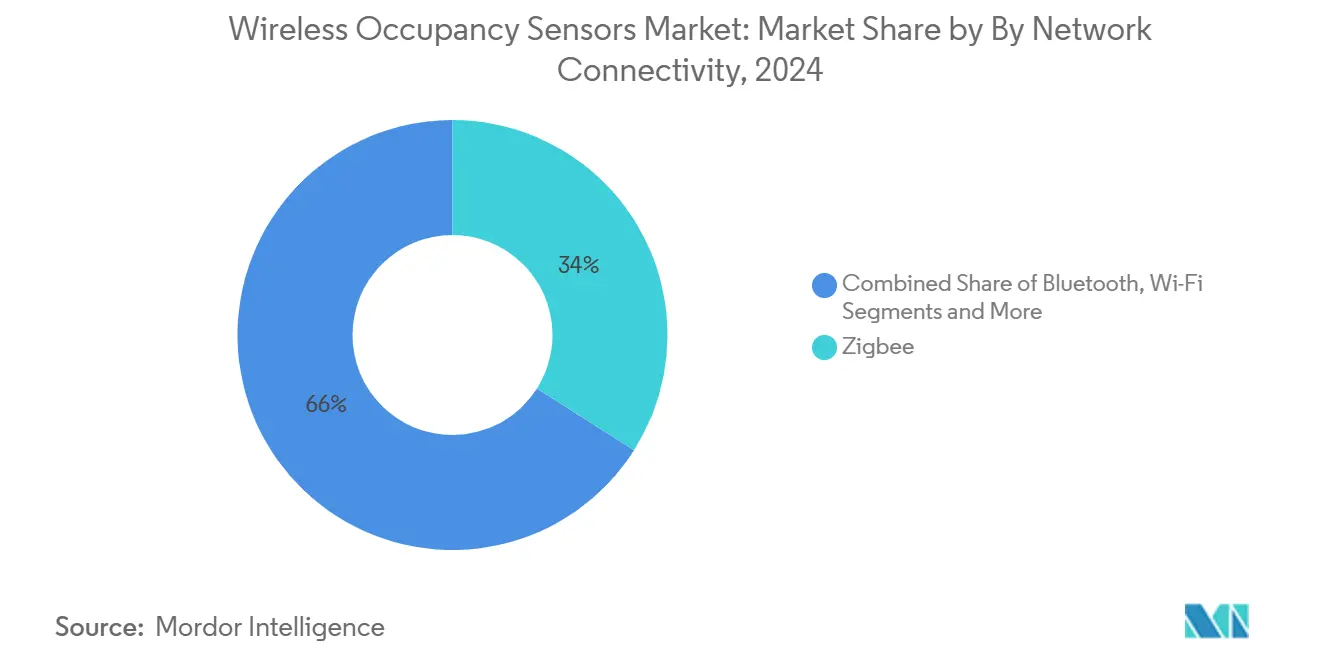
Note: Segment shares of all individual segments available upon report purchase
By End-User Industry: Smart Buildings Anchor Convergence
Smart Buildings form the largest end-user block, spanning office towers, malls, and mixed-use complexes that integrate lighting, HVAC, and space-management dashboards. Healthcare registers the fastest growth as facilities upgrade for pandemic resilience and regulatory compliance with indoor-air-quality norms. Manufacturing sites deploy sensors for area isolation during machinery service and to verify worker presence in hazardous zones. Aerospace & Defense demand hardened, tamper-proof devices compliant with strict security frameworks.
Consumer Electronics & Smart Home buyers emphasize plug-and-play setup via mobile apps, encouraging low-cost BLE models. Retailers exploit people-count feeds for dynamic merchandising and checkout staffing. Transportation hubs overlay sensors on existing lighting circuits to monitor crowding and guide ventilation. The convergence of requirements across industries promotes scale economies that reinforce the competitive position of platform vendors in the wireless occupancy sensors market.
Geography Analysis
North America led with a 35% revenue share in 2024, powered by ASHRAE 90.1-2019 and Title 24 codes that mandate sensors in virtually all commercial projects. The United States spearheads mmWave radar R&D, with firms such as Novelda delivering ultra-wideband detectors capable of micro-motion tracking for patient-room applications Novelda. Canada’s LEED-centric retrofit drive and Mexico’s factory expansion sustain regional volume despite occasional trade policy uncertainties. The wireless occupancy sensors market continues to benefit from federal tax incentives for energy-efficient equipment upgrades.
Asia-Pacific is the fastest-growing territory, projected to post a 17.8% CAGR as China’s smart-city blueprint and Japan’s Zero-Energy-Building targets boost sensor penetration. India’s 100-Smart-Cities Mission and widespread 5G rollout create fertile ground for BLE-based installations in commercial towers. South Korea leverages its electronics manufacturing capacity to shorten lead times and reduce system prices, driving adoption in local education and healthcare sectors. Abundant local component supply shields the region from global chip shortages, reinforcing the wireless occupancy sensors market growth trajectory.
Europe benefits from the Energy Performance of Buildings Directive, which enforces periodic performance audits that spur continuous retrofit cycles. Germany excels in industrial automation synergies, while the United Kingdom channels carbon-reduction funds into public-sector retrofit grants. France explores smart-grid-to-building data exchanges that pay buildings for demand-response, making sensors revenue-generating assets instead of compliance costs. GDPR steers buyers toward edge-processed solutions, favoring vendors with on-device analytics. Together, these factors embed wireless sensors as a foundational element of Europe’s decarbonization roadmap.[3]Construction21, “China’s Smart City Projects Accelerate Intelligent-Building Adoption,” construction21.org
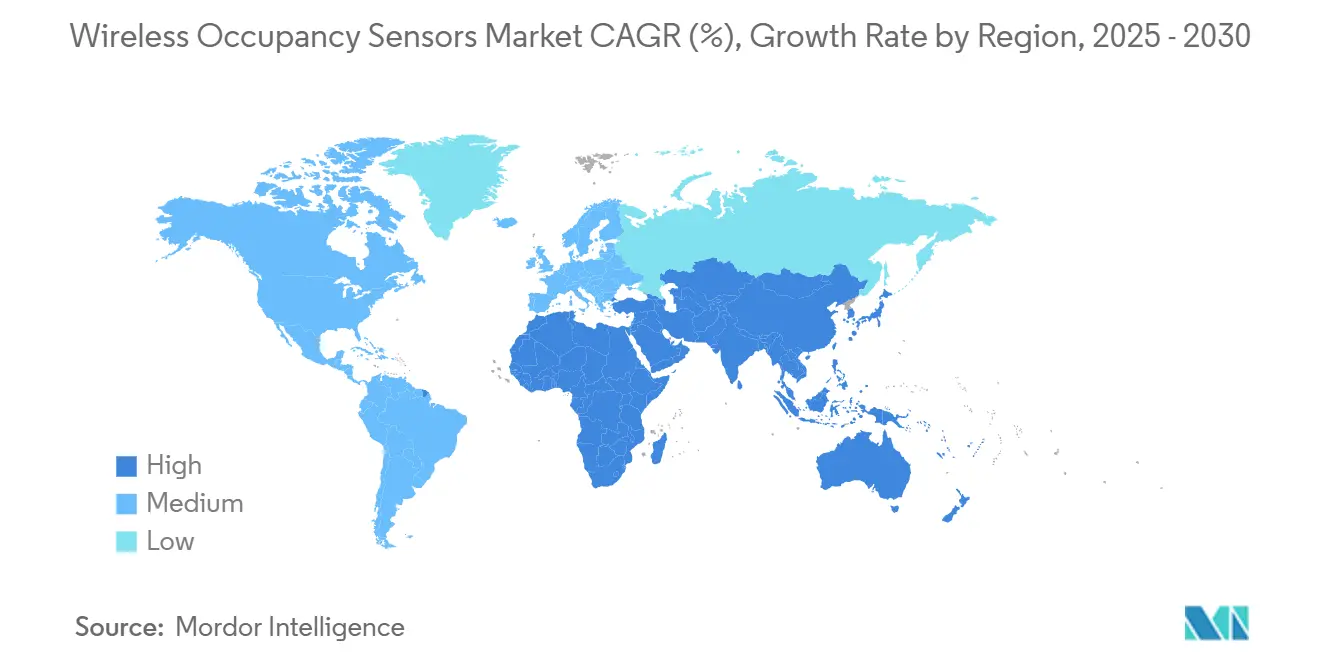
Competitive Landscape
The wireless occupancy sensors market exhibits moderate fragmentation, with lighting giants, diversified industrials, and specialized start-ups jockeying for share. Acuity Brands’ USD 1.215 billion purchase of QSC broadened its portfolio across audio, video, and control platforms, enabling holistic space data capture that differentiates against single-function rivals. Schneider Electric’s SpaceLogic controller fuses AI with multi-sensor inputs to achieve up to 35% HVAC energy savings, illustrating competitive emphasis on integrated value rather than standalone hardware.
Emerging disruptors such as EnOcean commercialize kinetic and solar harvesting modules that eliminate battery maintenance, opening cost-conscious verticals like logistics hubs that balk at lift rentals for ceiling access. VergeSense and Milesight add subscription-based analytics models layered on hardware, shifting revenue toward recurring software streams. Patent races focus on radar signal processing and ultra-low-power edge inference, with several players increasing R&D budgets to defend intellectual property advantages.
Strategic alliances also shape competition. ABB’s collaboration with Samsung embeds occupancy data into SmartThings for unified device orchestration, while Siemens, Enlighted, and Zumtobel co-develop sensor-embedded luminaires that accelerate project timelines. Market consolidation is expected as incumbents seek data-rich assets, yet niche innovators maintain footholds by owning specialized IP or vertical expertise. This dynamic ensures healthy innovation pipelines and user choice within the wireless occupancy sensors market.
Wireless Occupancy Sensors Industry Leaders
-
Legrand SA
-
Schneider Electric SE
-
Acuity Brands Inc.
-
Signify N.V.
-
Johnson Controls International plc
- *Disclaimer: Major Players sorted in no particular order
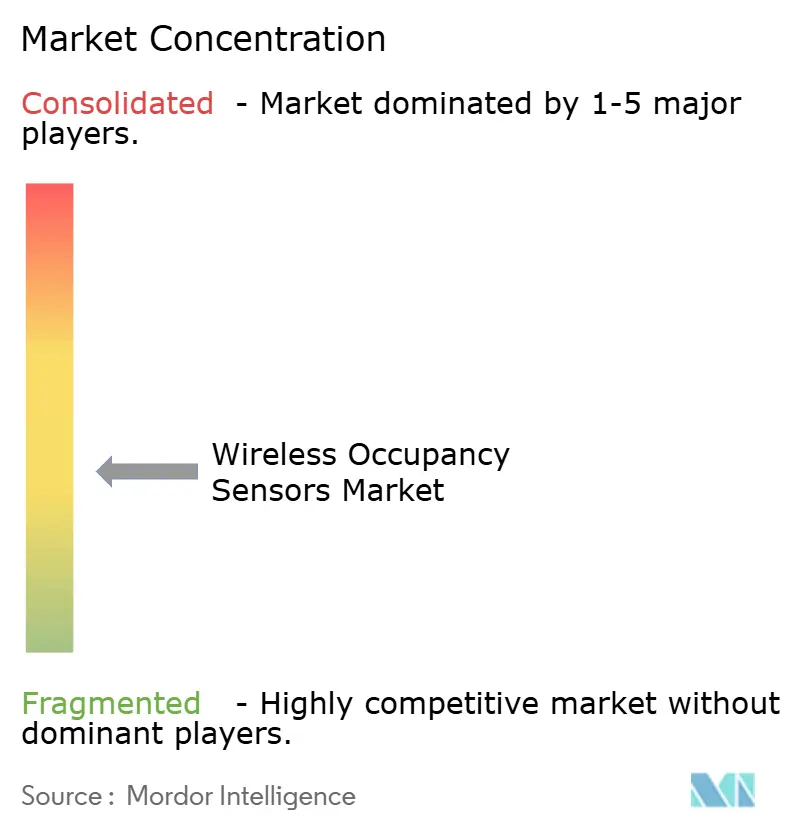
Recent Industry Developments
- January 2025: Acuity Brands completed its USD 1.215 billion acquisition of QSC, LLC, integrating cloud-manageable audio, video, and control platforms with occupancy sensing capabilities. The acquisition enhances Acuity's Intelligent Spaces Group revenue to USD 535 million annually and positions the company to leverage data interoperability across smart building applications.
- February 2025: Eaton Corporation announced a USD 340 million investment to establish transformer operations in Jonesville, South Carolina, creating 700 jobs and enhancing grid modernization capabilities. The facility will manufacture three-phase transformers supporting increasing electrical power demand from smart building deployments.
- February 2025: ABB and Samsung Electronics announced integration of ABB's InSite energy management system into Samsung's SmartThings platforms, enhancing energy management for residential and commercial buildings through unified occupancy sensing and smart appliance control.
- October 2024: Schneider Electric completed its investment in Planon Beheer B.V. to digitally transform buildings into sustainable workplaces, focusing on occupancy-based space optimization and energy management solutions.
Global Wireless Occupancy Sensors Market Report Scope
Wireless occupancy sensors can be defined as a system that turns off and on the light automatically depending upon the vacancy. It also controls the temperature and ventilation systems. It helps in making life convenient and easier and also saves energy. Various sensors used are the infrared, ultrasonic, microwave. humidity, and temperature, other sensors.
| Passive Infrared (PIR) |
| Ultrasonic |
| Dual Tech (PIR + Ultrasonic) |
| Microwave / mmWave Radar |
| Other Technologies |
| Lighting Control |
| HVAC and Ventilation |
| Security and Surveillance |
| Space-Utilization Analytics |
| Other Applications |
| Residential |
| Commercial |
| Industrial |
| Public and Institutional |
| Zigbee |
| Bluetooth / BLE |
| Wi-Fi |
| EnOcean (Energy-Harvesting) |
| LoRa and Other LPWAN |
| Smart Buildings |
| Healthcare Facilities |
| Manufacturing |
| Aerospace and Defense |
| Consumer Electronics and Smart Home |
| Others |
| North America | United States |
| Canada | |
| Mexico | |
| Europe | United Kingdom |
| Germany | |
| France | |
| Italy | |
| Rest of Europe | |
| Asia-Pacific | China |
| Japan | |
| India | |
| South Korea | |
| Rest of Asia-Pacific | |
| Middle East | Israel |
| Saudi Arabia | |
| United Arab Emirates | |
| Turkey | |
| Rest of Middle East | |
| Africa | South Africa |
| Egypt | |
| Rest of Africa | |
| South America | Brazil |
| Argentina | |
| Rest of South America |
| By Technology | Passive Infrared (PIR) | |
| Ultrasonic | ||
| Dual Tech (PIR + Ultrasonic) | ||
| Microwave / mmWave Radar | ||
| Other Technologies | ||
| By Application | Lighting Control | |
| HVAC and Ventilation | ||
| Security and Surveillance | ||
| Space-Utilization Analytics | ||
| Other Applications | ||
| By Building Type | Residential | |
| Commercial | ||
| Industrial | ||
| Public and Institutional | ||
| By Network Connectivity | Zigbee | |
| Bluetooth / BLE | ||
| Wi-Fi | ||
| EnOcean (Energy-Harvesting) | ||
| LoRa and Other LPWAN | ||
| By End-User Industry | Smart Buildings | |
| Healthcare Facilities | ||
| Manufacturing | ||
| Aerospace and Defense | ||
| Consumer Electronics and Smart Home | ||
| Others | ||
| By Geography | North America | United States |
| Canada | ||
| Mexico | ||
| Europe | United Kingdom | |
| Germany | ||
| France | ||
| Italy | ||
| Rest of Europe | ||
| Asia-Pacific | China | |
| Japan | ||
| India | ||
| South Korea | ||
| Rest of Asia-Pacific | ||
| Middle East | Israel | |
| Saudi Arabia | ||
| United Arab Emirates | ||
| Turkey | ||
| Rest of Middle East | ||
| Africa | South Africa | |
| Egypt | ||
| Rest of Africa | ||
| South America | Brazil | |
| Argentina | ||
| Rest of South America | ||
Key Questions Answered in the Report
What is the projected size of the wireless occupancy sensors market by 2030?
The market is expected to reach USD 2.3 billion by 2030, reflecting a 15.9% CAGR.
Which region shows the fastest growth potential for wireless occupancy sensors?
Asia-Pacific is forecast to grow at a 17.8% CAGR, driven by China’s smart-city rollouts and Japan’s zero-energy-building initiatives.
Why are Dual-Tech sensors gaining popularity?
They combine PIR and ultrasonic detection to cut false triggers, leading to a 20.5% CAGR, the highest among technology segments.
How do battery-free sensors impact total cost of ownership?
Kinetic and solar energy-harvesting designs remove battery replacement labor and disposal fees, significantly lowering lifecycle costs.
What application segment is expanding fastest in this industry?
HVAC & Ventilation integration is advancing at a 19% CAGR as buildings tie airflow to real-time occupancy data to meet ESG goals.
What key restraint could slow adoption?
Data-privacy and cybersecurity concerns, especially under GDPR rules, can lengthen procurement cycles and curb deployment speed.
Page last updated on:
